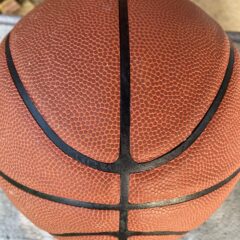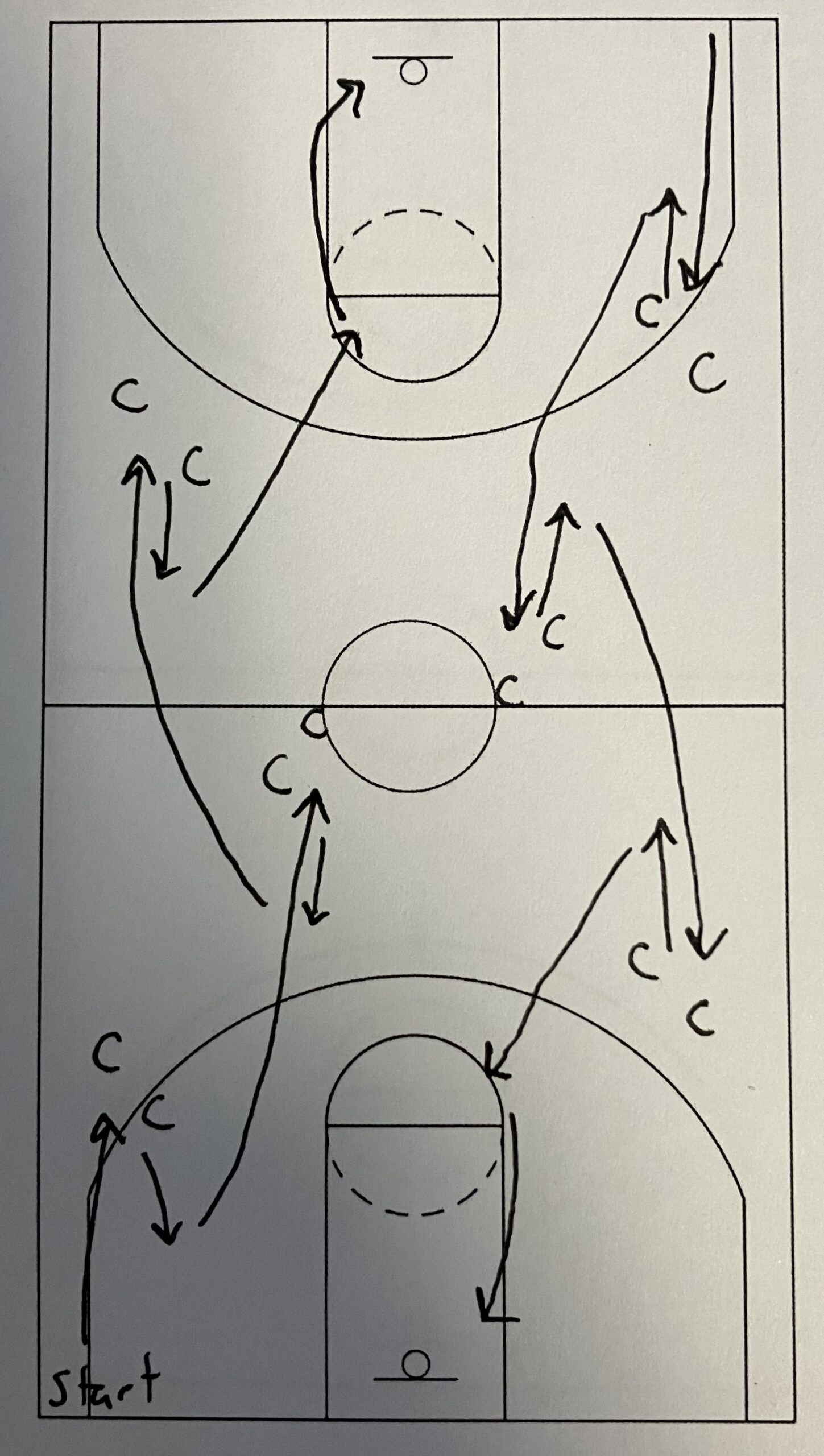The single biggest skill needed as a basketball player is dribbling. The dribble is the single most important part of any basketball player. Even though dribbling is the most important skill needed, most players do not work on game time dribbling during their practices. I have seen a lot of different drills that “help” to improve ball handling but the skill in order to do those drills have no fundamental basis during a game. These drills can help improve the ability to dribble. They can help improve body coordination or hand eye coordination. However, they have no game relevance.
These types of drills are the ones using tennis balls or two basketballs. There are others that use travelling or double dribbling within the drill itself. While these types of drills may help ball handling; there is a need to work on game type dribbling.
Basketball is a game of movement and space. The dribble must be used to create movement such as changing directions or create space by moving sideways or backwards. Dribbling drills need to be designed so players are forced to create movement and/or create space. These types of movement is what is being forgotten when tennis balls or two basketballs are introduced.
There are five different change of direction dribbles which can used either offensively or defensively depending on when and where they are used. If you want to become a better basketball player, then learn and get better using all 5 of these dribbles. The better you become with these dribbles, the better basketball player you will become.
1) Crossover
The crossover is moving the ball from one hand to the other in front of your body. The hand should be placed on the side of the ball and pushed across the body. The other hand should be receiving the ball. This dribble can be used to change direction left or right by switching the dribbling hand. It can also be used to move backwards to create space between yourself and a defender by pulling the ball in a backwards motion. This backwards dribble should be about a 10:30 to 4:30 dribble on a clock or a 1:30 to 7:30 depending on which hand is dribbling the ball. This should be the first move taught to new players as it requires the least amount of movement and body coordination. Also make sure the hand is not being put on the bottom of the ball. This will make the hand flip palm up to palm which is a violation. Although if done quickly and smoothly, it may not be called. Look up Allen Iverson. Most of his crossovers start with his hand on the bottom of the ball which should not have been allowed.
2) Behind the Back
This would be the second dribble I teach young players. There are two variations of this dribble. The first is the wraparound. This is the variation I prefer. This is where a player wraps the ball around the back and is trying to reach around to be able to push the ball past the opposite hip. So if the dribble is right handed, then the right hand is trying to get the ball past the left hip before releasing the dribble to the floor and back into the left hand. This is the more aggressive offensive version.
The second variation is more of an “under the butt” dribble. This is where the ball is pushed under the butt from one hand to the other. This is going to take the the ball handler in a natural backwards or sideways direction. This variation is more defensively in nature to create space between the ball handler and the defender.
3) Between the Legs
This is a more advanced dribble just due to the size needed to be able to dribble a basketball between the legs in a natural motion. This dribble may not be accomplished by any players until they get to about 5th grade. The legs should be in a staggered stance while the player pushes the ball between the legs from one hand to the other. The bounce should take place right about on the line between the two feet. The dribble can be accomplished by taking the ball either front to back or back to front. I teach only the dribble going from front to back.
The back to front dribble is easily stolen if the catch is not done cleanly. The front to back keeps the body in between the defender and ball if the bounce is not caught cleanly. When done cleanly and smoothly, it is a crossover but puts the body in a good position to help keep a defender away from getting a steal. Also this move does require more body control to keep everything in sync. Once mastered, this is a great move to change direction and change the tempo of the dribble. It can be used very effectively to go from either moving fast to slow or as an attacking offensive player it can be used moving slowly to attacking with a quick and fast movement.
4) Spin Move
The spin move is the most difficult to use effectively out of the 5 different moves. This is for two reasons. First, it takes a lot of body control to do a 360 degree spin while maintaining a legal dribble through the entire process. Second, it takes away the vision of the ball handler during the move. The dribbler needs to have the court understanding to know where everybody is at the exact moment the spin is completed.
From my experience most players are just not able to lose their vision during the move and come out of the spin knowing exactly where they are at as well as everybody on the court. So I do not work as much on the spin move as I do the other 4 moves.
The actual dribble is a pull dribble finished with a push dribble. The dribble is done by pulling the ball while turning 180 degrees with your back to the defender. As the half turn is completed the pull stops and lets the ball bounce to maintain a legal dribble. Then the dribble is picked up with the other hand and a push dribble is done while turning the last 180 degrees for a complete spin. In order for it to be really effective it needs to be done quickly. This just normally does not occur with high school players.
I will teach the spin move but I try to teach it less as a dribble and move as a move right at the basket to be able to move into a good spot to shoot a layup around defenders. I am hoping by removing the dribble aspect of the spin move, it reduces the amount of possible double dribbling or traveling violations that are called.
5) Back Dribble
I think the back dribble is the most important dribble in basketball. It allows a dribbler to get themselves out of a bad position. However, it is also the least used dribble in my opinion.
The back dribble is almost a completely defensive dribble. It gives the ball handler the ability to create space between themselves and the defender. I drill the back dribble as the escape to a defensive trap. When done correctly, the back dribble gives a team getting trapped the ability to pass out of the trap and into an offensive opportunity. It gives the space needed to pass out of the trap which leads to the defense defending a man down.
The back dribble should be done by putting the butt towards the offensive basket while looking over the off dribble shoulder. Then two hard dribbles and explosion steps should be taken going away from the offensive basket. If done quickly this gives the dribbler the space needed away from the defender to pick up the dribble and make a pass to a teammate. A lot of turnovers can be prevent if the back dribble is utilized.
The offensive back dribble is normally called the step back. In dealing with high school kids, most of them do not have the ability and strength to dribble backwards and shoot shots with any consistency. Most step back shots are made at a very low percentage among high school players. So I do not allow step back shots. We should be able to get a better shot as a team without using a low percentage shot.
Conclusion
Basketball is about scoring more points then the other team. The dribble is the way the offensive team can get themselves into a better position to take a better shot during games. However, game type dribbles are not always practiced by players. These five dribbles are the only change of direction moves there are in basketball. Everything you see is just a variation of one of these five moves.
The difference between an elementary kid and a professional is the speed in which the move is done and the ability to do multiple change of direction moves back to back. A player that can do double moves and triple moves quickly will be a problem for any defender at the high school level and below. If you a coach, then start teaching and drilling these five moves. It does not have to be a huge time commitment but some time should be spent drilling these moves. If you are a player and are looking to improve, then start practicing each of these moves. Then start working on going straight from one move to a second change of direction move. The quicker you can do each move the better player you will become.


21 thoughts on “Dribbling Fundamentals”